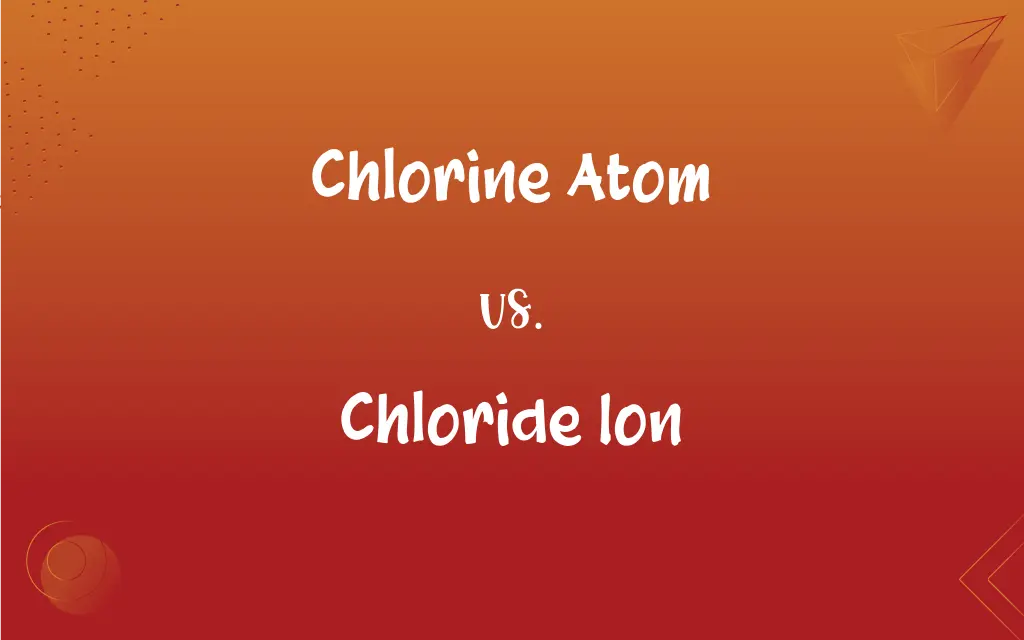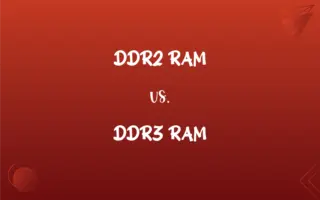Chlorine Atom vs. Chloride Ion: What's the Difference?
By Janet White || Published on January 28, 2024
Chlorine Atom is an element with 17 protons and electrons. Chloride Ion is a chlorine atom that has gained an extra electron, carrying a negative charge.

Key Differences
Chlorine Atom is an element with atomic number 17, meaning it has 17 protons in its nucleus and, when neutral, 17 electrons. Chloride Ion is a chlorine atom that has gained an extra electron, resulting in a negative charge.
Chlorine Atoms are found in various compounds and in elemental form in nature. They have a balanced charge due to an equal number of protons and electrons. Chloride Ions, with an extra electron, have a -1 charge, making them anions.
The properties of a Chlorine Atom, such as its reactivity and role in chemical reactions, are defined by its 17 electrons. The additional electron in a Chloride Ion changes its chemical properties, making it more stable and less reactive.
Chlorine Atoms can participate in various types of chemical bonding, including covalent and ionic. When a Chlorine Atom becomes a Chloride Ion, it often forms ionic bonds, especially with metals.
In the periodic table, Chlorine Atoms are located in Group 17, known for their high electronegativity. Chloride Ions are the result of chlorine's high affinity for electrons, easily forming stable ions.
ADVERTISEMENT
Comparison Chart
Charge
Neutral (equal number of protons and electrons)
Negative (-1, due to an extra electron)
Electron Configuration
17 electrons, seeking to gain one more
18 electrons, achieving a stable configuration
Chemical Reactivity
Highly reactive, seeking to gain an electron
Less reactive, having gained an electron
Occurrence
In elemental form and in compounds
Predominantly in ionic compounds
Bonding Preference
Can form covalent or ionic bonds
Primarily forms ionic bonds
ADVERTISEMENT
Chlorine Atom and Chloride Ion Definitions
Chlorine Atom
Chemical Building Block.
Chlorine atoms are integral to many organic molecules.
Chloride Ion
Ionic Compound Component.
Chloride ions are key in forming table salt.
Chlorine Atom
Valence Electron Holder.
The chlorine atom has seven valence electrons, making it highly reactive.
Chloride Ion
Stabilized Particle.
The chloride ion has a complete octet, making it stable.
Chlorine Atom
Halogen Member.
As a halogen, the chlorine atom has high electronegativity.
Chloride Ion
Negative Charge Bearer.
The chloride ion's negative charge is crucial in electrochemical reactions.
Chlorine Atom
Reactive Entity.
The chlorine atom reacts vigorously with metals.
Chloride Ion
Anionic Form.
The chloride ion is prevalent in saltwater.
Chlorine Atom
Elemental Particle.
A chlorine atom is essential in the synthesis of chlorinated compounds.
Chloride Ion
Electron Acceptor.
In forming the chloride ion, the chlorine atom gains an electron.
FAQs
How does a chlorine atom become a chloride ion?
By gaining an electron, typically from a metal or another electron donor.
What is a chlorine atom?
A chlorine atom is an element with 17 protons and, typically, 17 electrons.
Why is the chloride ion less reactive than the chlorine atom?
The chloride ion is less reactive because it has a stable electron configuration.
Can chlorine atoms exist independently in nature?
Chlorine atoms usually bond with other elements due to their high reactivity.
What defines a chloride ion?
A chloride ion is a chlorine atom that has gained an extra electron, carrying a -1 charge.
What are the uses of chloride ions?
Chloride ions are used in everything from salt production to electrochemistry.
Can chloride ions conduct electricity?
Yes, in solution or molten form, chloride ions can conduct electricity.
What role do chloride ions play in the human body?
Chloride ions help regulate fluid balance and are part of stomach acid.
How does the reactivity of chlorine atoms impact their use?
Their high reactivity makes them useful in disinfection and manufacturing.
How are chlorine atoms obtained industrially?
Through processes like electrolysis of saltwater.
What is the role of chloride ions in cleaning products?
They're often part of disinfectants and bleaches.
Are chlorine atoms dangerous?
Elemental chlorine can be hazardous due to its high reactivity.
Are chlorine atoms heavier than chloride ions?
They have the same atomic weight, but the chloride ion has an extra electron.
Is a chlorine atom larger than a chloride ion?
No, a chloride ion is slightly larger due to increased electron-electron repulsion.
Are chloride ions found in drinking water?
Yes, in small quantities, for taste and as a disinfectant.
Can chlorine atoms be used in medicine?
Yes, in the synthesis of certain pharmaceuticals and disinfectants.
Do chloride ions have any environmental impact?
Excessive chloride ions can harm aquatic life and affect water quality.
Can chlorine atoms form molecules with themselves?
Yes, they form diatomic molecules (Cl₂) under standard conditions.
How do chlorine atoms interact with organic molecules?
They can react to form various organic compounds, including pesticides.
What happens to chloride ions in chemical reactions?
They typically pair with metal ions to form salts.
About Author
Written by
Janet WhiteJanet White has been an esteemed writer and blogger for Difference Wiki. Holding a Master's degree in Science and Medical Journalism from the prestigious Boston University, she has consistently demonstrated her expertise and passion for her field. When she's not immersed in her work, Janet relishes her time exercising, delving into a good book, and cherishing moments with friends and family.






































































